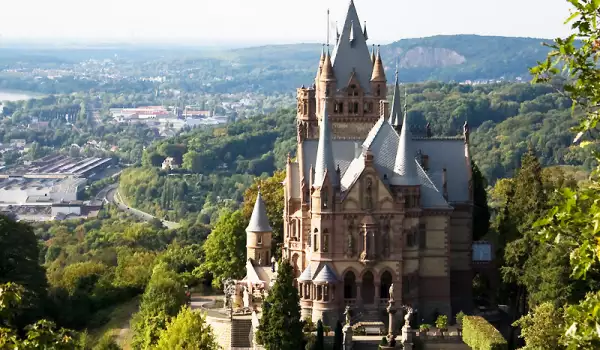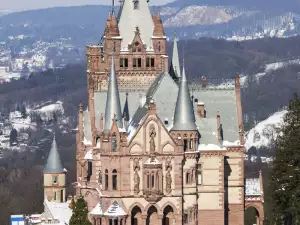Drachenburg Palace

Drachenburg Palace seemed to emerge out of a fairy tale among the wooded hills of the mountainous northern province of Rhine-Westphalia. The romantic architecture of the palace stands among the beautiful thick forests of Mount Siebengebirge and the castle also offers a wonderful view over the course of passing below the Rhine river.
As one of the biggest attractions not only for the region of Westphalia, but also for the entire course of the Rhine, Drachenburg Palace welcomes thousands of tourists annually. Many of them come with a boat cruise on the river. This palace is one of the largest in this part of the country in the 19th century.
The foundations of the castle Drachenburg were made in the years between 1882 - 1884 by the order of Baron Stephan von Sarter. This man was a wealthy stockbroker from Bonn and was knighted by one of the Dukes of Saxony.
Amazingly his private mansion was complete for these two years, after which the eponymous hill of Drachenfels became home to the romantic castle. It is today one of the prides of the Königswinter city.
Baron Stefan von Zarter had bright plans to live in the lovely castle, but they never took place as sadly Baron died in 1902. The architecture of the castle is defined as a historicism style and is the work of architects, Leo von Abbema and Berngard Tüshaus.

After their work the castle was completed by William Gofman, who was a disciple of the notorious Ernst Friedrich Zwirner. These craftsmen created a unique natural architecture of the palace which intertwines a lot of historical stages of construction.
Drachenburg Palace has an abundant of windows, towers, pinnacles and bay windows. In stark contrast to the medieval architecture of the castle is a modern building of the 19th century, which has gas lighting and central air heating system, etc.
After the death of the original owner, the castle was passed into the hands of his nephew, Jakob Hubert Biesenbach, who decided to regain his investment in the palace by making it accessible to the public and also decided to sell the works of art in the socalled showroom.
Drachenburg Palace was heavily damaged during the bombing in World War II. In the postwar period after 1960 it was completely neglected and crumbling. In 1972 Paul Spinat was the man who saved Drachenburg of doom as he engaged in its restoration and a year later, the palace was open to the public. He lived in Drachenburg until his death during 1989.
After this period, the castle became the property of the province, which undertook a major restoration and was then declared a historical monument. There are different parts of the palace, which must be seen, including the Church of St. Michael, Summer Museum and others.















